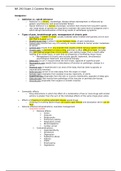Exam (elaborations)
NR 293 Exam 2 Content Review- NR293 Exam 2 Content Review Study Guide
- Course
- NR 293 Exam 2 (NR293EXAM2)
- Institution
- Chamberlain College Of Nursing
Analgesics: • Addiction vs. opioid tolerance o Addiction is a chronic, nerobiologic disease whose development is influenced by generic psychosocial, and environmental factors. o Opioid tolerance is a normal physiologic condition that results from long term opioid use, large doses of opioids a...
[Show more]



